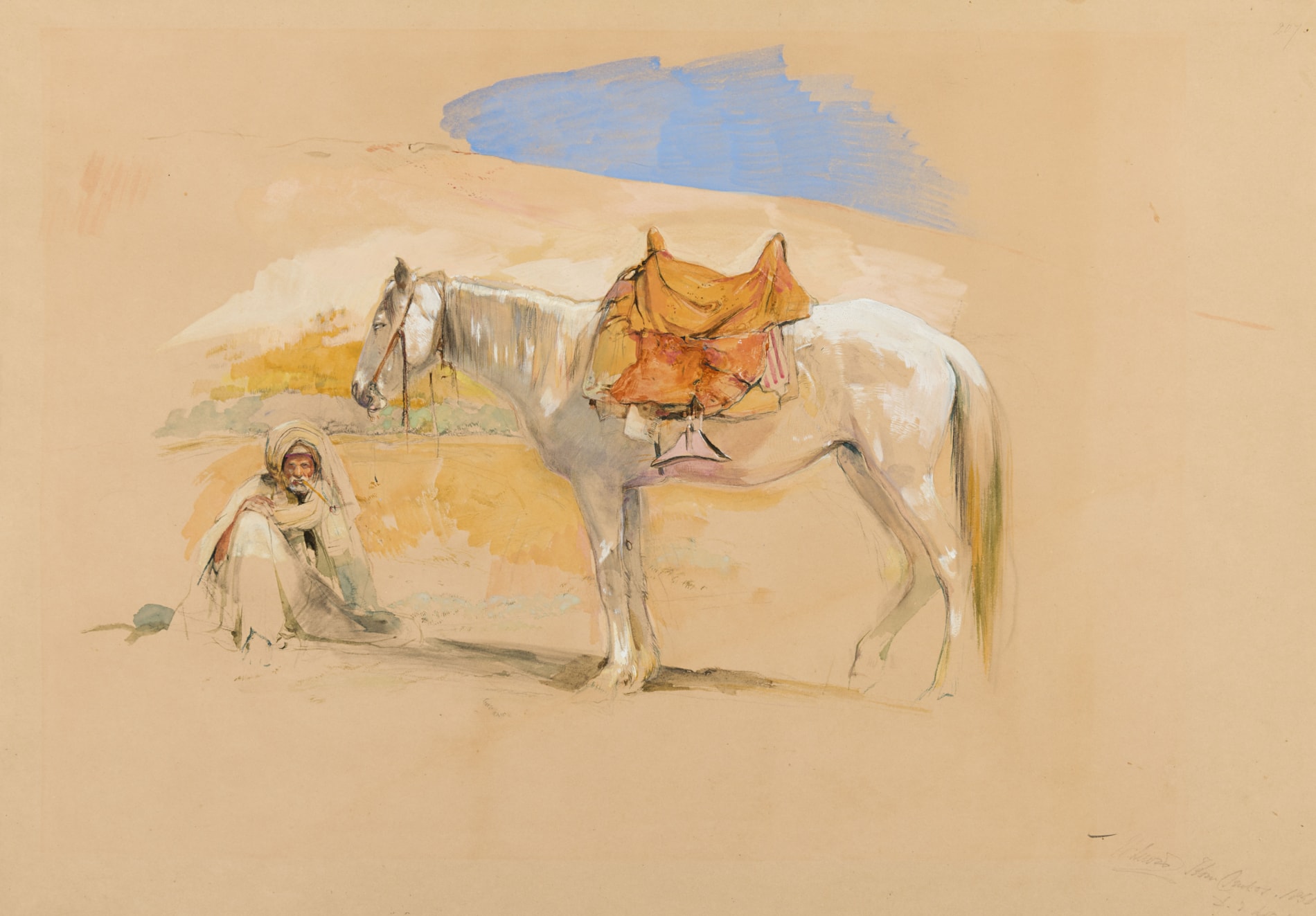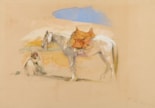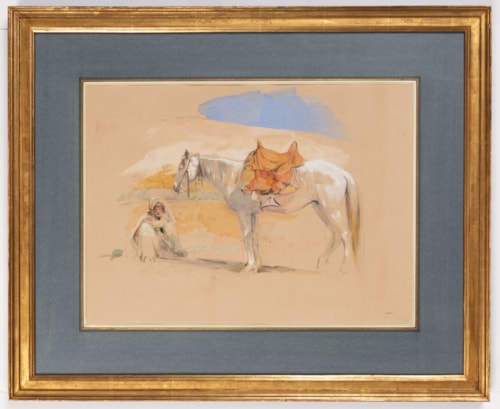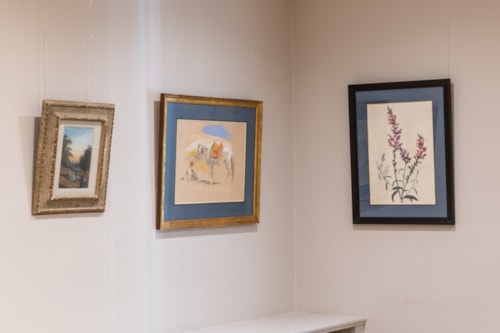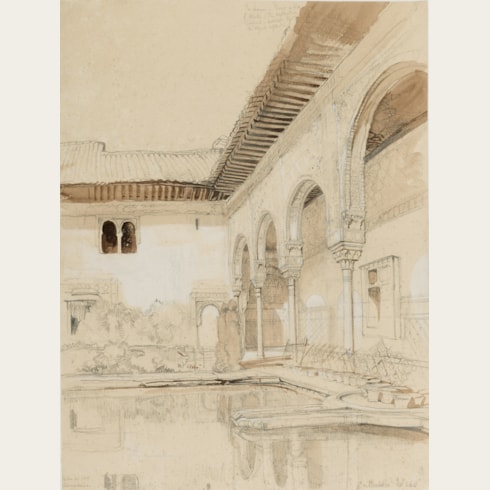John Frederick LEWIS
(London 1805 - Walton-on-Thames 1876)
Sheikh el Belled, Kom Ombos, Upper Egypt
Watercolour and gouache, over traces of an underdrawing in pencil.
Signed, inscribed and dated J. F. Lewis Kom Ombos. 1850. / l. d. [?] at the lower right.
331 x 452 mm. (13 x 17 3/4 in.) [image]
367 x 526 mm. (14 1/2 x 20 3/4 in.) [sheet]
Signed, inscribed and dated J. F. Lewis Kom Ombos. 1850. / l. d. [?] at the lower right.
331 x 452 mm. (13 x 17 3/4 in.) [image]
367 x 526 mm. (14 1/2 x 20 3/4 in.) [sheet]
During his decade in Cairo, John Frederick Lewis only seems to have made one trip to Upper Egypt, in 1849-1850 at the end of his stay, when he was accompanied by his wife Marian. The couple visited Thebes and Edfu, and travelled as far south as Philae, where they met Florence Nightingale, before returning north to Cairo via Kom Ombo, where they arrived in February 1850. About a hundred miles south of Luxor, Kom Ombo (also Kom Umbu or Ombos) was a town on the eastern bank of the Nile famous for its double temple, built during the Ptolomeic dynasty in the 2nd century BC and dedicated to both the crocodile god Sobek and Horus, the falcon god. Lewis made several drawings of the temple and the inhabitants of Kom Ombo, of which the present sheet is a fine example.
A printed inscription on the former mount, probably transcribed from a now-lost label, identifies the subject of this watercolour as the ‘Sheikh el Belled’ (shaykh al-balad, or the headman of a village). The sheikh is shown alongside his white horse, both apparently resting after a long journey. As has been noted of Lewis, ‘Time and again, his sketches from his Nile trip reveal that his interest lay in the rural life of Upper Egypt rather than with the ancient monuments that most tourists travelled there to see.’ Also drawn at this time was a stylistically comparable watercolour of An Arab with Two Oxen Ploughing at Kom Ombos, which, like the present sheet, was in the 1877 studio sale, and recently reappeared at auction in London.
This large sheet is one of two watercolours with identical titles included in the sale of the contents of Lewis’s studio in May 1877, the year after the Lewis’s death. It seems to have been unsold and remained with the artist’s widow until May 1897, when it was sold at auction. The present sheet was later acquired from art dealers Agnew’s by the Yorkshire councilman, industrialist and university chancellor Arthur Greenlow Lupton (1848-1930).
One of the two known watercolours of this title was sent by Lewis to the Royal Academy exhibition of 1870; an indication of the esteem in which he held the composition. The other version of this subject was purchased at the posthumous 1877 Lewis studio sale by the London-based framers, gilders and fine art dealers William and John Henry Vokins, who specialized in watercolours, and recently appeared at auction.
A printed inscription on the former mount, probably transcribed from a now-lost label, identifies the subject of this watercolour as the ‘Sheikh el Belled’ (shaykh al-balad, or the headman of a village). The sheikh is shown alongside his white horse, both apparently resting after a long journey. As has been noted of Lewis, ‘Time and again, his sketches from his Nile trip reveal that his interest lay in the rural life of Upper Egypt rather than with the ancient monuments that most tourists travelled there to see.’ Also drawn at this time was a stylistically comparable watercolour of An Arab with Two Oxen Ploughing at Kom Ombos, which, like the present sheet, was in the 1877 studio sale, and recently reappeared at auction in London.
This large sheet is one of two watercolours with identical titles included in the sale of the contents of Lewis’s studio in May 1877, the year after the Lewis’s death. It seems to have been unsold and remained with the artist’s widow until May 1897, when it was sold at auction. The present sheet was later acquired from art dealers Agnew’s by the Yorkshire councilman, industrialist and university chancellor Arthur Greenlow Lupton (1848-1930).
One of the two known watercolours of this title was sent by Lewis to the Royal Academy exhibition of 1870; an indication of the esteem in which he held the composition. The other version of this subject was purchased at the posthumous 1877 Lewis studio sale by the London-based framers, gilders and fine art dealers William and John Henry Vokins, who specialized in watercolours, and recently appeared at auction.
After some early success as a painter, mostly of animal subjects (an interest he shared with his childhood friend and neighbour Edwin Landseer), John Frederick Lewis seems to have largely given up painting around 1830, in favour of drawings and finished watercolours. These works were exhibited at the Society of Painters in Water-Colours (to which he had been elected as an associate in 1827, at the age of just twenty-one), the Royal Academy, the British Institution and elsewhere. He made his first trip abroad in 1827, visiting Belgium, Germany, Switzerland and Italy. Between 1832 and 1834 Lewis lived and worked in Spain, producing numerous drawings, watercolours and lithographs of local sights, figures, costumes, buildings and landscapes. Spanish subjects dominated his exhibited output of finished watercolours for most of the succeeding years, as well as two volumes of lithographs published in 1835 and 1836, earning him the nickname ‘Spanish Lewis’. In 1837 Lewis left London to travel to Italy, where he spent two years, and from there went on to Greece, Albania and Turkey before eventually settling in Egypt at the end of 1841.
Lewis resided in Cairo for ten years, living as an Oriental gentleman in an elegant Ottoman house in the Azbakiyyah quarter of the city, dressing in the Turkish manner and enjoying what one visitor, the writer William Makepeace Thackeray, described as a ‘dreamy, hazy, lazy, tobaccofied life.’ He produced a large number of watercolours and drawings during his decade in Egypt before his return to England in 1851. For the remainder of his career he painted Orientalist subjects inspired by his years in the East, and based largely on the drawings made in Cairo. These depictions of mosques, bazaars, Eastern interiors, desert encampments and imaginary harem scenes proved immensely popular with collectors. In 1855 Lewis was elected President of the Society of Painters in Water-Colours, although the previous year he had also begun to exhibit paintings at the Royal Academy. His growing interest in oil painting, at the expense of watercolours, led him in February 1858 to resign from the Old Water-Colour Society, and for the remainder of his career Lewis’s exhibited works were mainly paintings. Elected an Associate of the Royal Academy in 1859 and an Academician in 1864, Lewis showed regularly at the Academy until his death in 1876.
Lewis’s paintings and watercolours of exotic Eastern subjects, executed in a meticulous and detailed manner, remained popular with collectors and connoisseurs throughout the later stages of his career. As his fellow artist and traveller Edward Lear noted, in a letter to Lewis’s wife written the year before the painter’s death, ‘There have never been, and there never will be any works depicting Oriental life – more truly beautiful and excellent – perhaps I might say - so beautiful and excellent. For, besides the exquisite and conscientious workmanship, the subjects painted by J. F. Lewis were perfect as representations of real scenes and people.’
Provenance
The posthumous Lewis studio sale, London, Christie’s, 4-7 May 1877, lot 132 (unsold)
Sale (‘Fifty Remaining Works of that Distinguished Artist, John Frederick Lewis, R.A. (Sold by the Direction of the Widow)…’), London, Christie’s, 3 May 1897, lot 39 (‘SHEIK EL BELLED, and horse’), bt. W. Rome for £26.5.0)
Thomas Agnew & Sons, Manchester and London
Purchased from them by Arthur Greenlow Lupton, Leeds
Thence by descent.
Sale (‘Fifty Remaining Works of that Distinguished Artist, John Frederick Lewis, R.A. (Sold by the Direction of the Widow)…’), London, Christie’s, 3 May 1897, lot 39 (‘SHEIK EL BELLED, and horse’), bt. W. Rome for £26.5.0)
Thomas Agnew & Sons, Manchester and London
Purchased from them by Arthur Greenlow Lupton, Leeds
Thence by descent.
Literature
Emily M. Weeks, Cultures Crossed: John Frederick Lewis and the Art of Orientalism, New Haven and London, 2014, p.182, note 90.
Exhibition
Probably London, Royal Academy, 1870, no.580 (as A Scheik el Belled, Upper Egypt).

